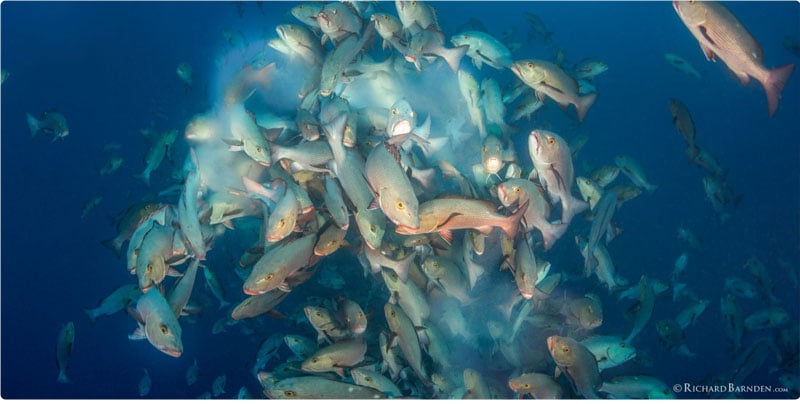First of all let us wish you a happy Easter and we hope that your egg hunt will be fruitful!
While we all tend to think about chocolatey egg shaped treats at this time of year, what better opportunity is there to talk about our underwater friends and their own particular eggy behaviour.
As some of you may know, most fishes use the oviparity technique. That’s to say they lay their eggs with little or no other embryonic development within the mother. But this method of reproduction is then divided into guarded and unguarded options
Unguarded – Spawning
Spawning generally means that females produce huge amounts of eggs, up to 6 million unfertilised eggs per individual. The eggs get released into the water column to be fertilised externally by males.
These events are regulated by nature, often the moon cycle, which means they are quite predictable and relatively easy to spot.
Generally you just need to watch out for large gatherings of one particular fish species in a single place. Essentially this is a fishy version of everyone heading out drinking on a Saturday night!
One of the best places for you to witness these events is Palau. You can join our special itineraries based on the full and new moon phases to see these amazing displays as they happen.

Full-moon spawning
During full-moon diving itineraries, up to 10,000 red snappers gather together for this monthly event. As the sun rises and the current picks up you will witness an amazing show where females shoot to the surface with males in chase releasing eggs and sperm in a mad dance.
As the snapper are completely focused on their spawning, these events often attract multiple shark shark species who see this as a perfect breakfast buffet.

New-moon spawning
During new-moon itineraries, bumphead parrotfish gather for what is believed to be the largest bumphead aggregation yet known on the planet.
We all know how rare it is to see these mighty fish, but to see hundreds of them together is a truly awe inspiring sight. This spawning also takes place early in morning, just as the sun rises and all elements of light, current and tides align.
The bumpheads change colour and after a gentle, and sometimes slightly manic, mating dance the females will shoot into the water column. They are chased by the males and they all release clouds of eggs and sperm in the hopes of starting life’s great dance.
Guarded
While spawnings are spectacular, with action left right and centre, there are some species that are a little more shy and like to keep things low key. But if you open your eyes, the eggs are still there to hunt out. Some species to start you off are:
Clown fish
Clownfish eggs are some of the easier eggs to find! Mainly because they are right by the anemones the fish are living in. You know where to start looking! The eggs are laid on a rock under or next to their anemones. The laying tends to occur on the waxing gibbous (between full and half) moon. The young are normally ready to hatch around the full moon. If you happen to pass an anemone during these times, spend a few minutes searching. But be aware…clownfishes might be small but they are feisty and will defend their eggs tooth and nail. If you are patient enough and the fishes accept you, then you may witness them tending to their eggs. The dotting parents blow on them and brush them with their fins.

Cardinal Fish
These are quite spectacular and somewhat unusual! The male actually incubates the eggs inside its mouth. That’s right…they keep them in their mouths from laying to hatching. The eggs are normally deposited around the new moon and hatch around the full moon. In order to find a male carrying eggs, just look at their extended and distended jaws. You need to be patient and allow the fish to accept you. If you’re lucky then you will be rewarded with a sight of the eggs! Every few minutes, a male cardinal fish will partially open its mouth to rotate the eggs. This is so they all grow to the same size. This process also allows to evacuate waste and renew aeration.

Ghost pipefish & pipefish
Both these species (similarly to their cousins seahorses) have a clearly full egg pouch. It is quite easy to spot a “pregnant one”. They both tend to start their cycle around the waxing moon to hatch at full moon. The species though are a little different. In the pipefish, the males carry the eggs while in the ghost pipefish, it is the female’s role. The way they carry their eggs is also rather different. The pipefish will attach them in a line under their belly and you can see the eggs straight away. Whereas for the ghost pipefish, only patience will reward you! As with the cardinal fish, the female will open her pouch at intervals to aerate the eggs. With luck, you will be able to see the eggs inside the pouch.

We hope these tips will help you finding the Easter eggs of the underwater world.



